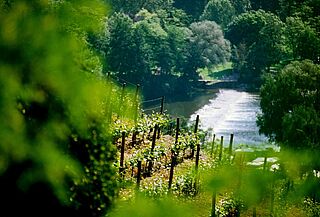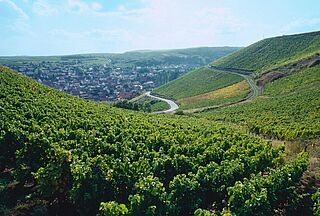Rotenberg
Kendte vinmarker
The Red Hill in the Alsenz River Valley: Rotenberg in Altenbamberg/Nahe
In honor of Valentines Day and the color of love, we turn our attention this month to a little-known and very small, but special, vineyard site in the Alsenz River Valley: Rotenberg (literally, red hill). It is a steep site near the town of Altenbamberg, just a few kilometers south of Bad Kreuznach, the wine capital of the Nahe region.
Altenbamberg lies at the foot of the ancient castle ruins of Burg Altenbaumburg, directly opposite the Rotenberg site. Its name “red hill” derives from its soil – Rotliegendes, a mixture of weathered, clayish red slate and sandstone, whose iron oxide content lends it a bright red color – similar to the soils of Rheinhessen’s renowned Roter Hang, the vine-clad “red slope” that overlooks the Rhine in Nierstein and Nackenheim, south of Mainz. The soil stamps the character of the first-rate Riesling wines produced here: they are both spicy and complex, but need at least a couple of years of bottle aging for their rough edges to mellow and aromas to come forth.
Altenbamberger Rotenberg’s original size of 9 ha/22 acres has been consciously reduced to a productive area of some 6 ha/15 acres, five hectares of which are owned by the Gutsverwaltung Niederhausen-Schlossböckelheim. This estate has had holdings there since 1956...for half a century! And this, despite the fact that much vineyard maintenance and harvesting must be done by hand due to the steepness of the site. Furthermore, given the site’s proximity to the forest, there is an annual battle with birds, boar and deer that literally can “devour” the crop. Nevertheless, the estate treasures the site, most of which is planted with Riesling; 0.3 ha (3/4 of an acre) with Weissburgunder (Pinot Blanc). A predominantly southern exposure and protection from cold winds by the forested tops of the Hunsrück Hills make for a favorable microclimate. The vines at higher elevations ripen more slowly than those at the foothills, but the longer ripening period yields extremely aromatic wines.
Altenbamberger Rotenberg wines can be sampled at the estate in Niederhausen or at the restaurant in Burg Altenbaumburg.
Tips for Tourists
The Gutsverwaltung Niederhausen-Schlossböckelheim (8 km/5 miles north of the Rotenberg site) is idyllically perched on a hillside in the midst of vines. From the tasting room’s beautiful terrace there are panoramic views – a memorable backdrop for a glass of wine. The estate offers bed & breakfast in stylish guest rooms (5 doubles, 1 single) open from April through October. It is but a short hike through the vineyards to the next restaurant for a good meal – no problem with drinking and driving. Tel +49 (0)6758/92500. www.riesling-domaene.de
Don’t miss the fabulous view of the Rotenberg vineyard from the terrace of the castle restaurant, Burgrestaurant Altenbaumburg, before or after having a look at the open-air castle ruins. The Prietz family extends a hearty welcome to its guests all year round and every day of the week (especially long hours from April through October, 10:00 a.m. til midnight). The menu features seasonal specialties and Sundays, from 11:30 a.m., there’s “Bauernschmaus” (farmers’ feast), a hearty and reasonably-priced buffet. AmEx, MC, Visa. Tel +49 (0)6708/3551.
Fitness fans: The spas in Bad Kreuznach and Bad Munster am Stein-Ebernburg are but a few kilometers from Altenbamberg and/or Niederhausen. They are especially famous for their radon treatments (therapeutic for rheumatic disorders) but also offer many other health and wellness programs. The region also has a wealth of well-marked cycling and hiking trails. An especially picturesque hike takes in the trio of castles around Bad Münster am Stein-Ebernburg: Altenbaumburg, Rheingrafenstein and Ebernburg – replete with splendid vantage points.
Last but not least.....the legend of Burg Altenbaumburg castle: “The Maiden with a Heart of Stone.” The Raugraf (count) of Altenbaumburg had a wild, daredevil daughter who loved to ride, hunt and fight. Since the tomboy had no intention of falling in love and rejected all suitors, she came to be known as the “maiden with a heart of stone.”
One day, while she was sitting beneath a tree near the castle gate, a dark and ugly woman with seven hungry little boys approached her and asked for some bread. The maiden showed no mercy and shouted that she and her brood should go away. The desperate woman fell to her knees and continued to beg, whereupon the maiden ran off, threatening to set the dogs on the wretched bunch. As they left, the crone swore back at the heartless maiden with a prophecy: “You, too, will be a mother someday, the mother of seven boys all at once. They will be the curse of your life. When your life has turned into a living hell, perhaps then you’ll remember how you heartlessly turned away a mother in need.”
The maiden was upset by the curse, and more determined than ever not to marry...until she ran into a childhood playmate, who had returned to the region after years of travel. She fell in love with and married the knight of Monfort and within a year she was indeed the mother of seven little boys. Horrified that the beggar’s curse was coming true, she came up with a scheme to “change” her destiny.
Since her husband was away when she gave birth and didn’t know how many children had been born, she ordered an old, trusted servant to drown six of the babies. The servant carried them away in her apron – but en route to the pond, she encountered the knight, on his way home. He aked her what she had in her apron, and the frightened woman stuttered “puppies.” When the knight had a look, he saw the six baby boys and learned of his wife’s wicked plot. He drowned the servant and took the babies to a safe place. Back at home, he didn’t mention the incident, but his wife sensed that his love for her had grown cold. Indeed, the knight left her, taking the last baby with him.
Left alone to deal with her bad conscience, the woman became genuinely penitent. Ultimately, the knight of Monfort heard of her change of heart. He also yearned to see his other sons. Before doing so, he decided to stop at the castle to see if the rumors about his spouse were true. He arrived, camouflaged as a pilgrim, and was shocked to see a pale, drawn woman in a penitential robe. He then revealed his identity, whereby the woman began to sob, admitted her atrocity, and announced her plans to enter a convent.
The knight quickly rode away, but returned by evening to tell his wife that God is merciful and his mercy had absolved her of her sin. He, too, was wiling to forgive her. He then ushered her into another room, where seven healthy five-year-old boys were playing together. The curse of the beggar had been broken, for the maiden with a heart of stone had been transformed into a loving person. And the young family of nine lived.....
.....happily ever after. Quite a tale. But the message is food for thought: have a heart! We hope that you and your loved one will have a happy Valentine’s Day. Tip: prepare “lox for lovers” (see recipe of the month) and serve with a handwritten “coupon” for a romantic summer vacation in the Nahe region, complete with a visit to a spa and the home of the “maiden with a heart of stone.”
From Altenbamberg it is but a few minutes’ drive to the bed & breakfast in Niederhausen (mentioned above) or castle accommodations at Johann Lafer’s Stromburg in Stromberg. Lafer, one of Germany’s pioneer TV chefs, runs a top-class operation in the Stromburg castle – rooms decorated with flair, a Michelin-starred restaurant and a less formal, cozy restaurant that features local specialties. Last but not least: experience the friendly atmosphere of the Kruger-Rumpf wine estate’s Weinstube in Münster-Sarmsheim, opposite Bingen. Stefan Rumpf is an excellent winemaker; his wife Cornelia, an excellent cook. Cozy inside and idyllic outdoors, on the terrace. Riesling and Weissburgunder (Pinot Blanc) wines are estate specialties, along with a limited quantity of fabulous, spicy Scheurebe (pronounced “shoy ray beh”) wine.
Many thanks to Christian Vogt, administrator and cellar master at the Gutsverwaltung Niederhausen-Schloss Böckelheim, for background information and the photo. If your travels take you to the Nahe region, and the Gutsverwaltung, you’ll find Christian Vogt a wonderful source of information – not only about his estate and its wines, but also about the region. Again, many thanks!



